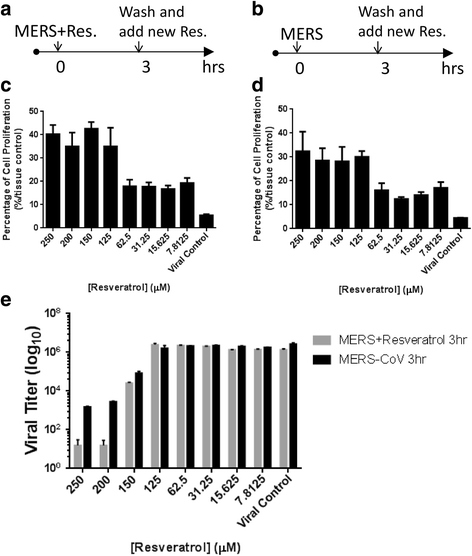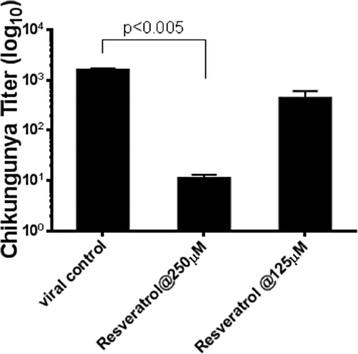Effective inhibition of MERS-CoV infection by resveratrol
- PMID: 28193191
- PMCID: PMC5307780
- DOI: 10.1186/s12879-017-2253-8
Effective inhibition of MERS-CoV infection by resveratrol
Abstract
Background: Middle East Respiratory Syndrome coronavirus (MERS-CoV) is an emerging viral pathogen that causes severe morbidity and mortality. Up to date, there is no approved or licensed vaccine or antiviral medicines can be used to treat MERS-CoV-infected patients. Here, we analyzed the antiviral activities of resveratrol, a natural compound found in grape seeds and skin and in red wine, against MERS-CoV infection.
Methods: We performed MTT and neutral red uptake assays to assess the survival rates of MERS-infected Vero E6 cells. In addition, quantitative PCR, western blotting, and immunofluorescent assays determined the intracellular viral RNA and protein expression. For viral productivity, we utilized plaque assays to confirm the antiviral properties of resveratrol against MERS-CoV.
Results: Resveratrol significantly inhibited MERS-CoV infection and prolonged cellular survival after virus infection. We also found that the expression of nucleocapsid (N) protein essential for MERS-CoV replication was decreased after resveratrol treatment. Furthermore, resveratrol down-regulated the apoptosis induced by MERS-CoV in vitro. By consecutive administration of resveratrol, we were able to reduce the concentration of resveratrol while achieving inhibitory effectiveness against MERS-CoV.
Conclusion: In this study, we first demonstrated that resveratrol is a potent anti-MERS agent in vitro. We perceive that resveratrol can be a potential antiviral agent against MERS-CoV infection in the near future.
Keywords: Inhibition; MERS-CoV; MERS-CoV virus infection; Middle East Respiratory Syndrome Virus; Resveratrol.
Figures







References
-
- Corman VM, Eckerle I, Bleicker T, Zaki A, Landt O, Eschbach-Bludau M, van Boheemen S, Gopal R, Ballhause M, Bestebroer TM, et al. Detection of a novel human coronavirus by real-time reverse-transcription polymerase chain reaction. Euro Surveill. 2012;17(39). http://www.eurosurveillance.org/ViewArticle.aspx?ArticleId=20285. - PubMed
-
- World Health Organization. WHO MERS-CoV Global Summary and risk assessment. 2016. http://www.who.int/emergencies/mers-cov/mers-summary-2016.pdf (MERS-CoV). Accessed 15 Dec 2016.
MeSH terms
Substances
LinkOut - more resources
Full Text Sources
Other Literature Sources

